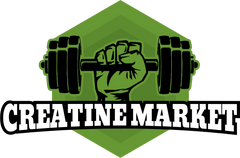If you're looking to understand the different types of creatine available today, you've come to the right place. Navigating through the various forms of creatine can be overwhelming, especially with new varieties constantly emerging in the supplement market. This comprehensive guide breaks down everything you need to know about the different types of creatine, their benefits, and how to choose the right one for your fitness goals.
What is Creatine and How Does it Work?
Creatine is a naturally occurring compound found in muscle cells that plays a crucial role in energy production during high-intensity, short-duration activities. Your body produces creatine from amino acids, and you can also obtain it from dietary sources, primarily meat and fish. However, supplemental creatine has become increasingly popular due to its proven benefits for muscle strength, power, and athletic performance.
The fundamental mechanism behind creatine's effectiveness lies in its ability to regenerate adenosine triphosphate (ATP), your body's primary energy currency. When you supplement with creatine, you increase your muscle's phosphocreatine stores, enabling more rapid ATP regeneration during intense exercise.
Creatine Monohydrate: The Gold Standard
Creatine monohydrate remains the most extensively studied and widely used form of creatine supplementation. This classic formulation consists of a creatine molecule bound to a single water molecule, creating a stable and highly effective supplement. Here's why it's considered the gold standard:
Extensive research has consistently demonstrated its effectiveness for increasing muscle strength and power, with hundreds of studies supporting its safety and efficacy over the past 30+ years
Creatine monohydrate is typically the most cost-effective form of creatine, offering excellent value for money while maintaining high quality
The absorption rate and bioavailability are well-documented, with proven results in both short and long-term supplementation protocols
See Creatine Monohydrate Vs HCL
Creatine Hydrochloride (HCL): Enhanced Solubility
Creatine HCL has gained popularity as an alternative to monohydrate, primarily due to its improved solubility. By binding creatine to hydrochloride, this formulation creates a more concentrated supplement that dissolves more readily in water. The potential benefits of creatine HCL include:
Better absorption rates due to increased water solubility
Lower effective dosing requirements compared to monohydrate
Reduced likelihood of digestive discomfort in sensitive individuals
However, it's worth noting that while creatine HCL shows promise, research comparing its effectiveness to monohydrate is still limited.
Micronized Creatine: Improved Mixability
Micronized creatine is essentially creatine monohydrate that has been processed to reduce particle size, typically to about 20 times smaller than regular creatine monohydrate. This modification offers several advantages:
- Enhanced mixability in liquids, reducing the grittiness often associated with standard creatine
- Potentially improved absorption due to the smaller particle size
- Greater surface area for dissolution, leading to better stability in solution
The micronization process doesn't change the fundamental properties of creatine monohydrate but rather improves its user experience characteristics.
Creatine Ethyl Ester: The Contested Alternative
Creatine ethyl ester (CEE) was developed with the goal of improving creatine absorption through enhanced cell membrane permeability. This form of creatine has an ester attached to its molecule, theoretically allowing it to bypass the creatine transporter system. However, research has yielded mixed results:
Some studies suggest that CEE may be less effective than monohydrate at increasing muscle creatine stores.
The ester group may be unstable in the digestive system, potentially converting to creatinine before absorption.
There is also a higher cost of creatine ethyl ester when compared to traditional monohydrate without proven superior benefits.
Buffered Creatine: pH-Adjusted Formula
Buffered creatine, often marketed as Kre-Alkalyn, is created by adding an alkaline powder to creatine to raise its pH level. The theory behind this modification includes:
- Increased stability in the digestive system
- Reduced conversion to creatinine
- Potentially improved absorption rates
While these claims are interesting, research comparing buffered creatine to monohydrate hasn't demonstrated significant advantages in terms of effectiveness or absorption.
Creatine Magnesium Chelate: Mineral-Enhanced
This form of creatine binds the compound to magnesium, creating a chelated supplement. The addition of magnesium aims to:
- Enhance creatine absorption through mineral transportation pathways
- Provide additional benefits from magnesium supplementation
- Improve stability and bioavailability
While this form shows promise, more research is needed on creatine magnesium chelate to definitively prove its advantages over traditional monohydrate.
Liquid Creatine: Convenience at a Cost
Liquid creatine supplements offer the appeal of ready-to-drink convenience, but they come with several significant drawbacks:
- Creatine can be unstable in liquid form, potentially breaking down into creatinine over time
- The effectiveness may be compromised compared to powder forms
- Higher cost per serving without proven benefits over traditional formats
For these reasons, liquid creatine is generally not recommended as a primary supplementation choice.
Ever Heard of Creatine Nitrate?
When exploring different forms of creatine supplements, athletes often encounter creatine nitrate, a specialized variant that combines creatine with nitrate molecules. This innovative formulation offers unique properties that may enhance solubility and absorption compared to traditional creatine monohydrate.
The addition of nitrate molecules could potentially provide added benefits through improved blood flow and muscle pumps during workouts. Because of its distinctive molecular structure and potential performance benefits, many athletes are considering creatine nitrate as an alternative to conventional creatine supplements.
Comparing Different Types of Creatine Supplements
When you start exploring creatine supplements, you'll quickly discover that there isn't just one type of creatine available. The supplement industry offers various forms, each claiming to be more effective than the others.
This variety can make choosing the right creatine supplement feel overwhelming, but understanding the key differences and comparisons of creatine types can help you make an informed decision.
Best Practices for Taking Creatine Supplements
Regardless of which type of creatine you choose, following these best practices will help maximize its benefits:
Optimal Dosing Strategies For Using Creatine
The most well-researched dosing protocol involves two phases:
1. Loading Phase (optional):
- 20-25g daily, split into 4-5 doses
- Duration: 5-7 days
2. Maintenance Phase:
- 3-5g daily
- Taken consistently at any time of day
Timing and Administration
While timing isn't crucial for creatine supplementation, consider these factors:
- Consistency is more important than specific timing
- Taking it with carbohydrates may enhance uptake
- Mixing with warm water can improve solubility
How to Choose the Right Type of Creatine
When selecting a creatine supplement, consider these factors:
Research Support on Creatine
Look for forms with substantial scientific backing demonstrating safety and efficacy. Creatine monohydrate leads in this category with decades of research support.
Cost Per Serving of Creatine
Compare the price per serving while considering the required dosage for each type. More expensive forms don't necessarily provide better results.
Individual Response
Some people may respond better to certain forms of creatine. Consider factors like:
- Digestive sensitivity
- Mixing preferences
- Budget constraints
Safety and Side Effects of Different Creatine Types
These different forms of creatine are generally recognized as safe, with an extensive body of research supporting its long-term use. However, be aware of these considerations:
- Proper hydration is essential when supplementing with any form of creatine
- Some users may experience initial water retention
- Quality matters – choose products from reputable manufacturers
Conclusion
Understanding the different types of creatine available can help you make an informed decision about supplementation. While newer forms may offer certain advantages in terms of solubility or mixability, creatine monohydrate remains the most well-researched and cost-effective option for most users. Whatever form you choose, consistent supplementation combined with proper training and nutrition will help you maximize the benefits of this powerful supplement.
Remember that individual responses may vary, and what works best for one person might not be optimal for another. Consider your personal needs, budget, and fitness goals when selecting a creatine supplement, and don't hesitate to experiment with different types to find what works best for you.



